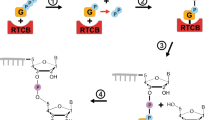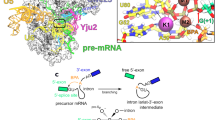Abstract.
The polypyrimidine tract binding protein (PTB) is a 58-kDa RNA binding protein involved in multiple aspects of mRNA metabolism including splicing regulation, polyadenylation, 3′end formation, internal ribosomal entry site-mediated translation, RNA localization and stability. PTB contains four RNA recognition motifs (RRMs) separated by three linkers. In this review we summarize structural information on PTB in solution that has been gathered during the past 7 years using NMR spectroscopy and small-angle X-ray scattering. The structures of all RRMs of PTB in their free state and in complex with short pyrimidine tracts, as well as a structural model of PTB RRM2 in complex with a peptide, revealed unusual structural features that provided new insights into the mechanisms of action of PTB in the different processes of RNA metabolism and in particular splicing regulation.
Similar content being viewed by others
Author information
Authors and Affiliations
Corresponding author
Additional information
Received 16 August 2007; received after revision 18 September 2007; accepted 2 October 2007
Rights and permissions
About this article
Cite this article
Auweter, S.D., Allain, F.HT. Structure-function relationships of the polypyrimidine tract binding protein. Cell. Mol. Life Sci. 65, 516–527 (2008). https://doi.org/10.1007/s00018-007-7378-2
Published:
Issue Date:
DOI: https://doi.org/10.1007/s00018-007-7378-2




